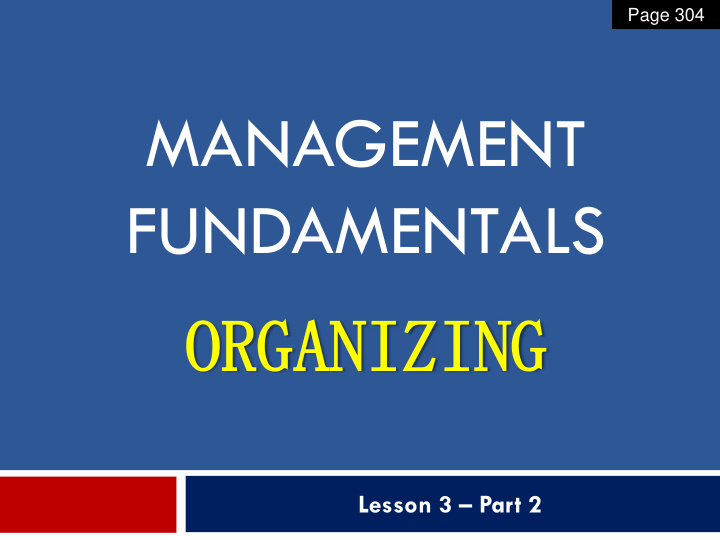



Page 304 MANAGEMENT FUNDAMENTALS ORGANIZING ORGANIZING Lesson 3 – Part 2
After developing plans, managers need to execute them. For that they need to organize people and necessary resources
Organizing - Definition Organising is the ‘deployment of organisational resources and grouping activities to achieve strategic goals’ To execute plans.. Organise people Organise Resources What to be done? Making structure Who will do?
Two common mistakes in resource allocation Over-deployment vs. Under-deployment
Organization Structure and Chart The way an organization has arranged its people and tasks is called as STRUCTURE Visual presentation of structure is called as CEO ORGANIZATION CHART Director / Director / General Manager General Manager - Operations - Administration Marketing Human Resource Finance Manager Senior Executive Manager Manager Sales Manager
ORGANIZATION CHART Positions are arranged as per the hierarchy of authority
Organisational Structural Design A process that involves decisions about six key elements 1. Chain of command 2. Span of control 3. Work specialization 4. Centralization and Decentralization 5. Formalization 6. Departmentalization 6/17/2019 GDM M 401 PB: HDM
Page 308 1 - Chain of Command Formal reporting relationships including lines of authority
CEO Director / General Manager – Director / General Manager - Director / General Manager Operations Administration Human Production Purchasing Stores Marketing Finance Resource IT Manager Manager Manager Manager Manager Manager Manager Senior Manager Sales Manager (02) (02) Sales executives (10) Chain of Command – The line or chain through which commands will flow Scalar Principle Rule that subordinates at every level should follow the chain of command and communicate with their seniors only through the immediate senior
Page 312 02 - The Span of Control The span of control is the number of subordinates reporting directly to the person above them in the hierarchy. 6/17/2019 GDM M 401 PB: HDM
Page 307 03 - Work Specialization Dividing work activities into separate job tasks. Also known as division of labour People become more expert in one task than they could be in several and are more likely to come up with improved ideas or methods.
Page 312 04 - Centralization and Decentralization Centralization is when a relatively large number of decisions are taken by management at the top of the organization. Decentralization is when a relatively large number of decisions are taken lower down the organization in the operating units.
05 - Formalization Formalization refers to how standardized an organization’s jobs are and the extent to which employee behavior is guided by rules and procedures ◦ These include rules, procedures, instruction manuals, job descriptions (things which people must do) 6/17/2019 GDM M 401 PB: HDM
6. Departmentalization Traditional approaches: Vertical Functional Divisional Matrix Innovative approaches: Teams Virtual Networks
Types of Organization Structures There are two types of basic structures Flat structure (Horizontal) WHERE CAN YOU SEE…... Tall structure - More hierarchical levels - Wider span of control (Vertical) - Longer chain of command - Quicker communication - More employee empowerment
Tall vs. Flat Organisational Structures 6/17/2019 GDM M 401 PB: HDM
Page 317 1. Vertical Functional Approach Grouping of positions into departments based on skills, expertise, work activities, and resource use 17
2. Divisional Approach Grouping based on organisational divisions: – Product, Program, Business divisions (self- contained unit), Geographies, etc. 18
Example: Divisional Approach Care Place Youth & Adult Environmental Child Care Care Care 19
Divisional structuring could also be done based on the geographic presence
Page 319 3. Matrix Approach • Matrix approach combines functional and divisional approaches – Improve coordination and information – Dual lines of authority Functional D i v i s i o n a l
Dual-Authority Structure in a Matrix Organisation Functions D i v i s i o n s
Global Matrix Structure Combining two divisional dimensions
4. Team Approach • Two types Cross Functional Teams and Permanent teams Brand manager CEO Production CEO manager New product Team 1 Team 2 Team 3 Development Team Marketing R & D manager manager
5. Virtual Network Approach Based on outsourced model Virtual network structure means that the firm subcontracts most of its major functions to separate companies
Delegation
Authority, Responsibility and Accountability Authority Formal and legitimate right given to take decisions, issue orders and allocate resources Given to a Increases position (not upwards in to a person) the hierarchy Authority Authority increases
Authority, Responsibility and Accountability Responsibility Duties to carryout or assigned activities E.g. Sales manager is responsible in brining money to the organization by selling products and services Accountability The obligation to report to superiors on performance ( also called as reporting)
3. Delegation of Authority The act of assigning formal authority and responsibility for completion of specific activities to subordinate/s A B E Responsibility + Authority C D F Question: What are the critical factors that managers have to consider whilst delegating work to subordinates?
Additional Reading Exhibit 10.9, page 326, Structural advantageous and Disadvantageous
The End Thank You
Recommend
More recommend